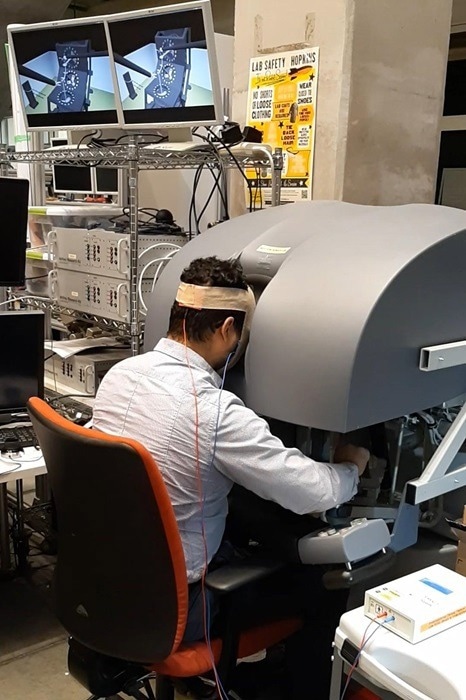
Image Credit: Johns Hopkins University
This discovery provides an initial insight into the potential benefits of stimulating the cerebellum, a specific region of the brain. According to Jeremy D. Brown, a Roboticist from Johns Hopkins University and the author of the study, this approach could prove instrumental in assisting healthcare professionals in seamlessly transferring their skills from virtual reality training to real operating rooms.
This transition is particularly crucial in a field increasingly reliant on digital simulation training.
Training in virtual reality is not the same as training in a real setting, and we've shown with previous research that it can be difficult to transfer a skill learned in a simulation into the real world.
Jeremy D. Brown, John C. Malone Associate Professor, Mechanical Engineering, Johns Hopkins University
Brown added, “It's very hard to claim statistical exactness, but we concluded people in the study were able to transfer skills from virtual reality to the real world much more easily when they had this stimulation.”
The study has been recently reported in the journal Nature Scientific Reports.
Participants performed a simulated surgical task involving driving a needle through three small holes.
This was done initially in a virtual setting and later in a real scenario using the da Vinci Research Kit, an open-source research robot. The exercises replicated the precise movements required for surgical procedures on abdominal organs, according to the researchers.
To stimulate the brain's cerebellum, participants experienced a subtle electric current through electrodes or small pads placed on their scalps. Half of the group received a continuous electric flow throughout the entire test, while the remaining participants received a brief stimulation only at the beginning, followed by no stimulation for the rest of the tests.
Those who received a continuous electric current demonstrated a significant improvement in dexterity. Notably, none of the participants had prior training in surgery or robotics.
The group that didn't receive stimulation struggled a bit more to apply the skills they learned in virtual reality to the actual robot, especially the most complex moves involving quick motions. The groups that received brain stimulation were better at those tasks.
Guido Caccianiga, Max Planck Institute for Intelligent Systems
The researchers highlighted that noninvasive brain stimulation is a technique that impacts specific brain areas externally, showcasing its potential to enhance motor learning in rehabilitation therapy.
Taking their research a step further, the team is exploring the application of brain stimulation to assist surgeons in acquiring skills essential for real-world situations.
This innovative approach aims to investigate the broader implications of stimulating the brain in professional training scenarios, as noted by co-author Gabriela Cantarero, formerly an Assistant Professor of physical medicine and rehabilitation at Johns Hopkins.
It was really cool that we were actually able to influence behavior using this setup, where we could really quantify every little aspect of people's movements, deviations, and errors.
Guido Caccianiga, Max Planck Institute for Intelligent Systems
Enhancing human skills, robotic surgery systems offer clinicians considerable advantages. They aid surgeons in reducing hand tremors, enabling the execution of fine and precise tasks with improved vision.
Besides influencing how surgeons of the future might learn new skills, this type of brain stimulation also offers promise for skill acquisition in other industries that rely on virtual reality training, particularly work in robotics.
Even outside of virtual reality, the stimulation can also likely help people learn more generally, the researchers said.
Caccianiga added, “What if we could show that with brain stimulation you can learn new skills in half the time? That's a huge margin on the costs because you'd be training people faster; you could save a lot of resources to train more surgeons or engineers who will deal with these technologies frequently in the future.”
The other authors of the study include Ronan A. Mooney of the Johns Hopkins University School of Medicine and Pablo A. Celnik of the Shirley Ryan AbilityLab.
Could an Electric Nudge to the Head Help Your Doctor Operate a Surgical Robot?
Could an Electric Nudge to the Head Help Your Doctor Operate a Surgical Robot? Video Credit: Johns Hopkins University.
Journal Reference:
Caccianiga, G., et al. (2023) Anodal cerebellar t-DCS impacts skill learning and transfer on a robotic surgery training task. Scientific Reports. doi.org/10.1038/s41598-023-47404-1.